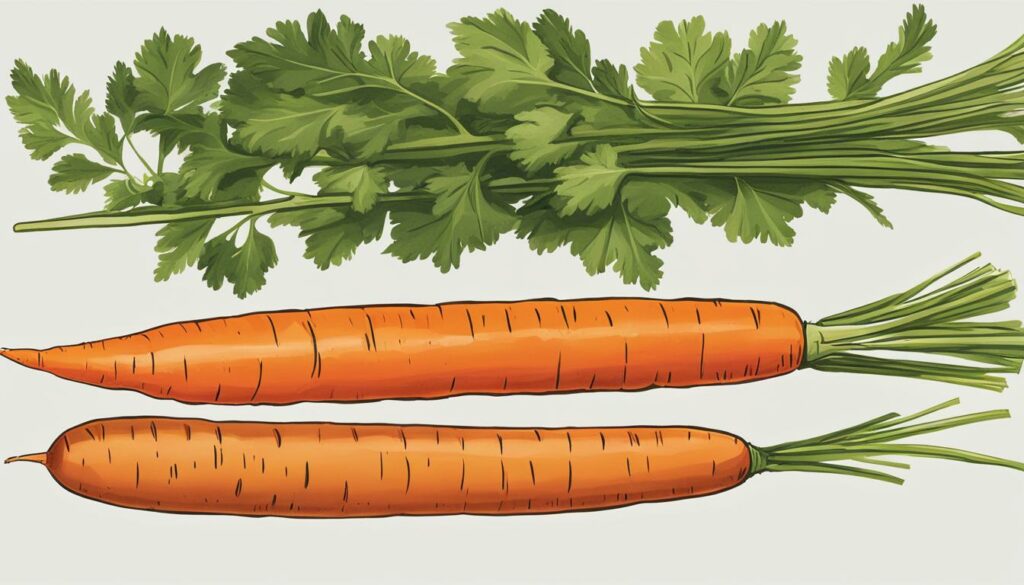Carrots are a versatile vegetable that comes in various sizes, shapes, and colors. From the typical orange carrot to white, yellow, and purple varieties, there’s a carrot to suit every taste. But have you ever wondered about the average carrot size?
The average carrot size can vary, with some measuring under 15cm, while others can exceed 30cm in length. Carrots have a crunchy texture, a slightly sweet and earthy flavor, and are packed with essential minerals and vitamins.
Whether you’re curious about carrot dimensions, carrot measurements, or simply want to know the standard carrot size, this article will provide you with all the fascinating facts and figures you need to know about the average size of carrots.
Different Types of Carrots: Exploring 5 Varieties
Carrots come in a variety of shapes, sizes, and colors, each with its own unique characteristics and flavors. Let’s explore five different types of carrots that are commonly cultivated worldwide:
1. Imperator Carrots
Imperator carrots are the most common type of carrot, known for their long and slender shape. They have pointed ends and a higher sugar content, giving them a sweeter taste. Imperator carrots are versatile and can be used in various culinary applications.
2. Chantenay Carrots
Chantenay carrots are characterized by their broad and stout shape. They are often grown in shallow or heavy soils and have a sweet and crisp texture. Chantenay carrots are perfect for roasting, grilling, or adding to soups and stews.
3. Miniature Carrots
Miniature carrots are tiny and ball-shaped, making them visually appealing to use in dishes. They are often used by high-end restaurants for their unique presentation. Despite their size, miniature carrots still pack the same nutritional punch as larger varieties.
4. Nantes Carrots
Nantes carrots are cylindrical and medium-sized, with a smooth texture and a slightly sweet taste. They are a popular choice for raw consumption and can be sliced or grated for use in salads and coleslaws.
5. Danvers Carrots
Danvers carrots are known for their ability to thrive in various soil conditions. They have a tapered shape and are easy to grow, making them a favorite among home gardeners. Danvers carrots are great for juicing, pickling, or adding to stir-fries.
Growing Carrots: A Step-by-Step Guide
Growing carrots is a rewarding experience that allows you to enjoy the freshness and flavor of homegrown produce. Follow these step-by-step instructions to successfully cultivate your own carrots:
1. Land Preparation:
Prepare the soil by removing any weeds or debris and breaking up any clumps. Carrots prefer loamy soil that is well-drained and loose, allowing the roots to grow straight and develop properly. Consider adding organic matter, such as compost or well-rotted manure, to enrich the soil and provide essential nutrients.
2. Seed Soaking:
Soak carrot seeds in water for a few hours before planting to promote germination. This step is especially beneficial for larger carrot varieties, as it helps to soften the seed coat and improve the chances of successful sprouting.
3. Fertilizing the Soil:
Before sowing the seeds, apply a balanced fertilizer that is rich in phosphorus and potassium to provide the necessary nutrients for healthy carrot growth. Avoid using nitrogen-rich fertilizers, as they can lead to excessive foliage growth at the expense of root development.
4. Sowing and Spacing:
Sow carrot seeds sparsely in shallow furrows or bands, ensuring they are evenly spaced. This allows enough room for the carrots to grow without overcrowding, which can result in stunted or misshapen roots. Aim for a spacing of approximately 2-3 inches between the seeds.
5. Irrigation and Weed Control:
Keep the soil consistently moist during the germination and early growth stages to encourage the development of strong roots. Once the carrot seedlings emerge, water deeply and regularly, ensuring the soil remains evenly moist but not waterlogged. Regularly remove any weeds that may compete with the carrots for nutrients and space.
6. Pest Management:
Protect your carrot crop from common pests such as carrot flies and aphids by using physical barriers, such as fine netting or row covers, to prevent them from accessing the plants. If necessary, consider using organic pest control methods or insecticidal soaps that are safe for edible crops.
7. Harvesting the Carrots:
Carrots are typically ready for harvesting when they reach the desired size and color. Depending on the variety, this can range from 60 to 80 days after sowing. Gently loosen the soil around the carrot roots and carefully lift them from the ground. Trim off the foliage, leaving a small portion of the green tops, and wash the carrots thoroughly before storing or using them in culinary preparations.
By following these simple steps, you can successfully grow your own delicious and vibrant carrots right in your backyard. Enjoy the satisfaction of nurturing and harvesting your own homegrown produce!
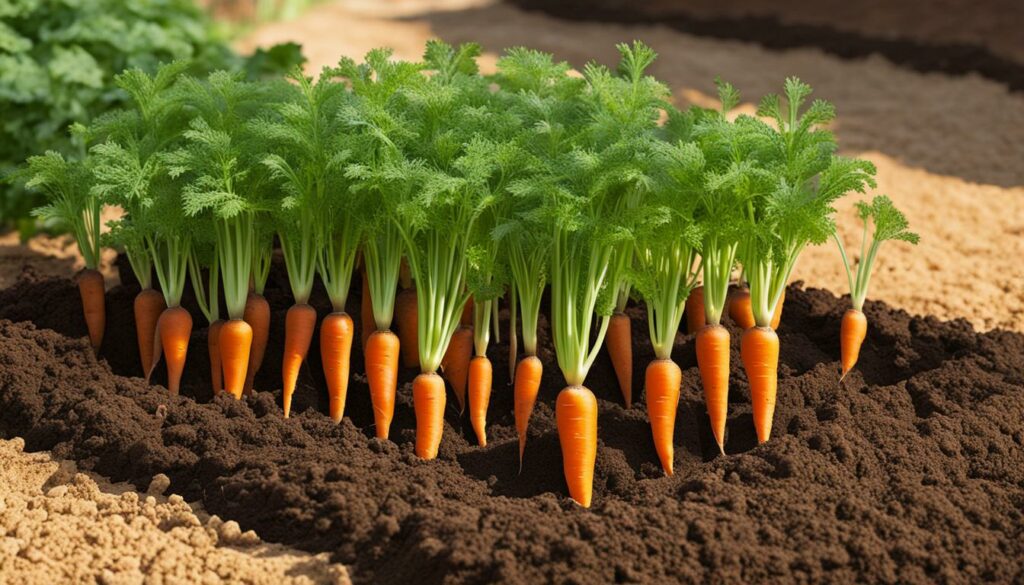
| Carrot Variety | Days to Maturity | Size/Shape | Flavor |
|---|---|---|---|
| Imperator | 70-80 days | Long, tapered | Sweet |
| Chantenay | 65-75 days | Broad, stout | Intense flavor |
| Miniature | 50-60 days | Small, ball-shaped | Tender, delicate |
| Nantes | 60-70 days | Cylindrical | Crunchy, sweet |
| Danvers | 70-80 days | Tapered, cylindrical | Well-balanced |
Health Benefits of Carrots: Promoting Eye Health and More
Carrots are not only delicious, but they also offer a wide range of health benefits. Their rich nutritional composition makes them an excellent addition to a balanced diet. Let’s explore the various ways that carrots can promote our overall well-being.
1. Carrots and Eye Health
One of the most well-known benefits of carrots is their positive impact on eye health. Carrots are packed with a unique compound called beta-carotene, which is converted into vitamin A in our bodies. This essential vitamin plays a crucial role in maintaining good vision, especially in low-light conditions. Including carrots in our diet can help protect against age-related macular degeneration, improve night vision, and prevent dry eyes.
2. Carrots for Weight Management
If you’re looking to maintain a healthy body weight or shed a few pounds, carrots can be an excellent addition to your weight management plan. Carrots are low in calories but high in dietary fiber, which helps you feel satisfied and full for longer periods. The fiber also aids in digestion and prevents constipation. By including carrots in your meals or enjoying them as a snack, you can curb hunger cravings and support your weight loss goals.
3. Carrots and Heart Health
Eating carrots regularly can contribute to a healthy heart. Carrots are rich in antioxidants, including beta-carotene and lutein, which help reduce oxidative stress and inflammation in the body. These compounds have been linked to a lower risk of heart disease and stroke. Additionally, the fiber content in carrots can help reduce cholesterol levels, further protecting the cardiovascular system.
4. Carrots and Cancer Prevention
Carrots contain various phytochemicals and antioxidants that have been shown to have anti-cancer properties. These compounds, including beta-carotene and falcarinol, have been studied for their potential to inhibit the growth of cancer cells and reduce the risk of certain types of cancer, such as lung, colon, and breast cancer. While more research is needed, incorporating carrots into your diet can be a simple and delicious way to support your overall health.
Incorporating carrots into your regular diet can provide a multitude of health benefits. From promoting eye health to aiding in weight management and protecting against heart disease and certain types of cancer, carrots are a nutrient-packed powerhouse. So, don’t forget to add this vibrant vegetable to your plate and enjoy its numerous advantages!
Fascinating Facts About Carrots: From Ancient Origins to Modern Delicacies
Carrots have a long and rich history dating back over 5,000 years. They originated in Afghanistan and were initially purple or white in color. It was through a genetic mutation that orange carrots were developed, and they eventually gained popularity around the world. Americans began incorporating carrots into their diets after World War I, recognizing their nutritional value and versatility in culinary applications.
Throughout history, carrots have held cultural significance in various countries. One notable example is Holtville, California, known as the “Carrot Capital of the World.” Holtville celebrates its carrot heritage with the annual Carrot Festival, showcasing the vibrant vegetable through parades, food contests, and other festivities. Carrots have also made their way into popular culture, appearing in literature, movies, and art, further cementing their place as a beloved and iconic vegetable.
One fascinating fact about carrots is their use beyond traditional culinary dishes. Carrots have inspired unique recipes and desserts, such as carrot cakes and carrot halwa. Additionally, carrots have found alternative uses in beauty products and skincare routines. Their high antioxidant content makes them a valuable ingredient in promoting healthy skin, leading to the development of carrot-based masks, creams, and serums.
Fun Facts About Carrots:
- The average carrot size can vary, with some measuring under 15cm, 15-30cm, and others longer than 30cm.
- Carrots come in various colors, including orange, white, yellow, and purple.
- Carrots were initially purple or white, and orange carrots developed through a genetic mutation.
- The “Carrot Capital of the World” is Holtville, California, which celebrates its carrot heritage with the Carrot Festival.
Table: Carrot Varieties
| Variety | Characteristics |
|---|---|
| Imperator | Long with pointed ends, higher sugar content |
| Chantenay | Broad and stout, grown in shallow or heavy soils |
| Miniature | Tiny and ball-shaped, often used by high-end restaurants |
| Nantes | Cylindrical and medium-sized, sweet taste |
| Danvers | Easy to grow, thrives in most soil conditions |
Carrots are not just an ordinary vegetable. They have a fascinating history, hold cultural significance, and offer versatile uses beyond the kitchen. Whether you’re enjoying a delicious carrot dish, exploring carrot festivals, or discovering carrot-based beauty products, carrots continue to captivate with their vibrant colors, unique flavors, and valuable health benefits.

Carrot Harvesting and Storage: Techniques and Tips
When it comes to harvesting carrots, timing is crucial. Carrots are typically ready for harvesting within 90-100 days, depending on the variety and growing conditions. To ensure optimal flavor and texture, it’s best to harvest carrots when they are fully mature but before they become overgrown or woody.
When harvesting carrots, gently loosen the soil around the base of the plant and carefully pull the carrot straight up to avoid any damage. If you encounter resistance, use a garden fork or a trowel to loosen the soil further and ease out the carrots.
Once harvested, it’s important to handle carrots with care to prevent bruising and damage. Remove any excess soil by gently brushing it off or rinsing the carrots with water if necessary. Avoid washing the carrots excessively, as this can contribute to moisture loss and reduce their shelf life.
To store carrots, remove the green tops (if still attached) as they can draw moisture from the roots. Place the carrots in a perforated plastic bag or a container lined with damp paper towels to maintain their moisture content. Store them in the refrigerator, preferably in the crisper drawer, where the temperature is slightly higher and more consistent.
Table: Carrot Storage Tips
| Storage Method | Duration |
|---|---|
| Refrigerator | Up to 3 months |
| Cellar or Root Cellar | Up to 6 months |
| Freezing | Up to 12 months |
Keep in mind that carrots stored in the refrigerator may lose some of their crispness over time, but they will still remain usable. If you have a root cellar or cool basement, carrots can be stored there for longer periods, often up to 6 months. Freezing is another option for long-term storage; simply blanch the carrots in boiling water for a few minutes, cool them quickly in ice water, and then pack them in airtight freezer bags or containers.
“Harvesting and storing carrots properly is essential to maintain their freshness and quality. By following these techniques and tips, you can enjoy the flavors and nutritional benefits of carrots throughout the year.” – Carrot Enthusiast

The Nutritional Value of Carrots: A Closer Look
Carrots are not only delicious and versatile in the kitchen, but they also offer a range of nutritional benefits. Packed with essential vitamins, minerals, and antioxidants, carrots are a fantastic addition to any diet.
The nutritional composition of carrots is impressive. These vibrant vegetables are low in calories and fat, making them a healthy choice for weight management. Carrots are also a good source of dietary fiber, which aids in digestion and promotes bowel regularity.
One of the key nutrients found in carrots is beta-carotene, a powerful antioxidant that gives carrots their orange color. In the body, beta-carotene is converted into vitamin A, which is essential for maintaining healthy vision, supporting the immune system, and promoting cell growth and development.
| Nutrient | Amount per 100g |
|---|---|
| Calories | 41 |
| Protein | 0.9g |
| Carbohydrates | 9.6g |
| Fat | 0.2g |
| Vitamin A | 8526 IU |
| Vitamin C | 5.9mg |
| Calcium | 33mg |
| Potassium | 320mg |
Including carrots in your diet can provide you with a range of health benefits. Whether enjoyed raw as a snack, steamed as a side dish, or incorporated into various recipes, carrots are a nutritious addition to any meal plan. So next time you’re at the grocery store, don’t forget to grab a bunch of these vibrant and nutritious root vegetables!
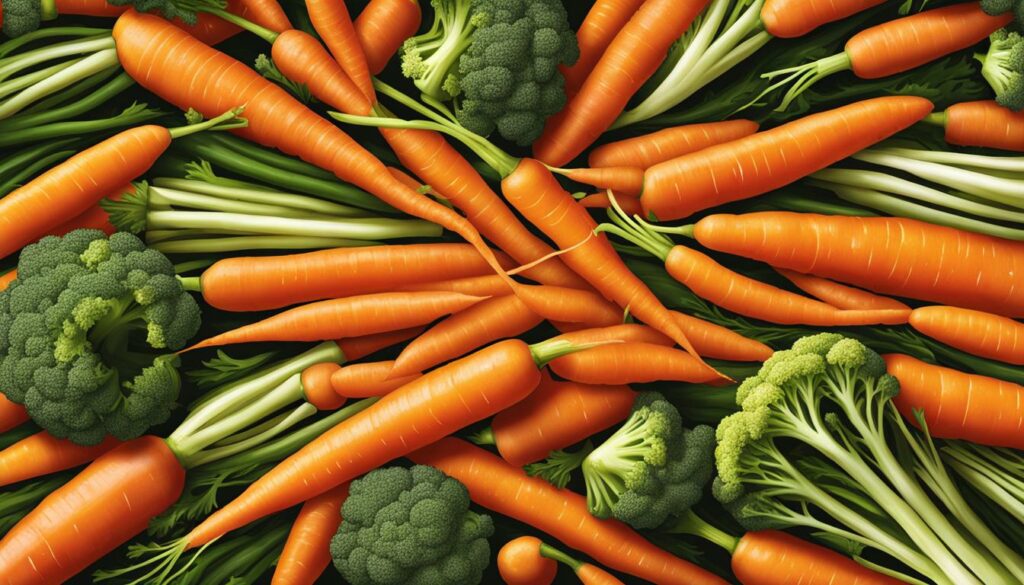
Carrots in Culinary Delights: Versatile and Delicious
When it comes to cooking with carrots, the possibilities are endless. This versatile vegetable can be incorporated into a wide range of dishes, adding flavor, texture, and nutritional value. Whether you’re looking for savory recipes, sweet desserts, or vibrant salads, carrots can elevate your culinary creations.
One popular way to incorporate carrots into your cooking is by using them in soups and stews. Their natural sweetness pairs well with savory ingredients, adding depth and complexity to the dish. Carrot soup, for example, is a comforting and nourishing option, perfect for chilly evenings. Simply sauté some onions and garlic, add chopped carrots, broth, and your favorite herbs and spices, then simmer until the carrots are tender. Blend until smooth, and you have a creamy and flavorful soup that’s sure to impress.
Carrots also shine in salads, bringing vibrant color and crunch to the mix. Grate some carrots and toss them with greens, nuts, and a tangy vinaigrette for a refreshing side dish. For a heartier meal, try adding roasted carrots to a grain salad or mixing them into a quinoa or couscous pilaf. The natural sweetness of the carrots complements the earthy grains, creating a harmonious and satisfying combination.
| Carrot Recipe | Preparation Time | Difficulty Level |
|---|---|---|
| Carrot Cake | 1 hour | Intermediate |
| Carrot Salad with Honey Mustard Dressing | 20 minutes | Easy |
| Honey Glazed Roasted Carrots | 40 minutes | Easy |
But let’s not forget about the wonderful world of carrot desserts. Carrot cake is a classic favorite, with its moist and spiced layers topped with cream cheese frosting. The grated carrots add both sweetness and moisture to the cake, making it a delightful treat for any occasion. If you’re feeling adventurous, you can also try making carrot cookies, muffins, or even carrot-flavored ice cream. The possibilities are truly endless when it comes to incorporating carrots into your sweet creations.
So next time you’re in the kitchen, don’t forget to reach for those vibrant orange roots. With their versatility and delicious flavor, carrots are sure to add a touch of magic to your culinary delights.
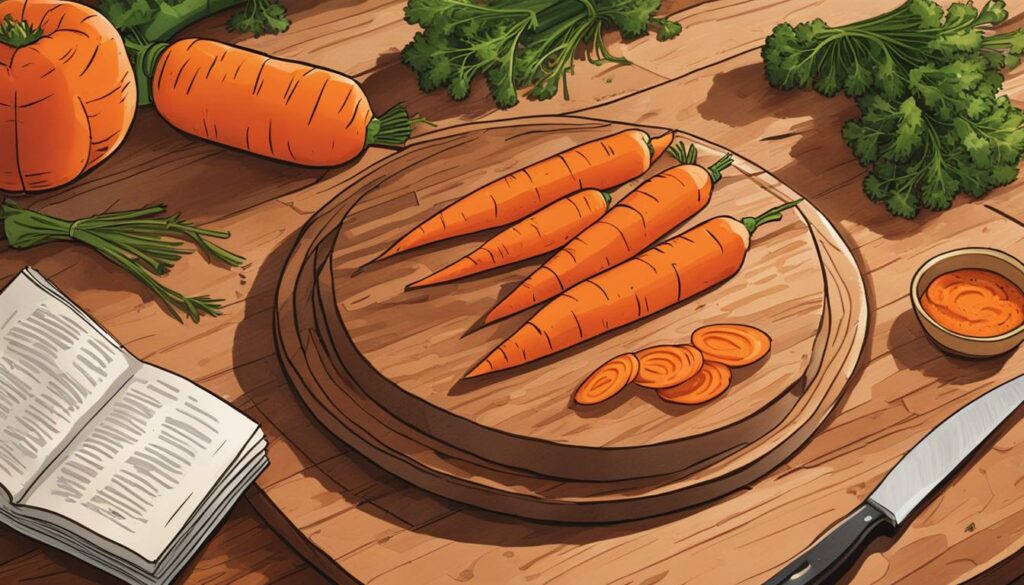
Carrots and Eye Health: Debunking the Myth
When it comes to carrots and vision, many have heard the age-old saying that eating carrots can improve your ability to see in the dark. While carrots are indeed rich in beta-carotene, a precursor to vitamin A which is essential for eye health, the belief that they grant superhuman night vision is simply a myth. (Image description: An image of a delicious carrot)
Beta-carotene is converted into vitamin A in the body, which plays an important role in maintaining good vision. It helps protect the surface of the eye (cornea) and is also necessary for the proper functioning of the retina. However, consuming excessive amounts of beta-carotene or carrots will not result in enhanced vision beyond what is considered normal.
While carrots do offer numerous benefits to eye health, such as reducing the risk of age-related macular degeneration and cataracts, it is important to maintain a balanced diet and overall healthy lifestyle for optimal eye function. Regular eye exams, proper nutrition, and protection from harmful UV rays are crucial for maintaining good eye health and preventing eye conditions. So, enjoy carrots as part of a well-rounded diet, but don’t rely on them alone to give you night vision capabilities.
Carrots as a Symbol of Health and Longevity
Carrots have long been regarded as a symbol of health and longevity. Their vibrant orange color and nutritious profile have made them a popular choice for those seeking a healthy lifestyle. Carrots are packed with essential vitamins, minerals, and antioxidants that contribute to overall well-being and vitality.
The association between carrots and health symbolism can be traced back to ancient traditions and folklore. In many cultures, carrots were believed to possess magical properties and were used as a talisman for good health. The belief in the power of carrots to promote longevity and well-being has been passed down through generations, making them an enduring symbol of health and vitality.
Furthermore, carrots’ nutritional composition supports their reputation as a symbol of health. They are rich in beta-carotene, an antioxidant that the body converts to vitamin A. Vitamin A is essential for maintaining healthy vision, promoting immune function, and supporting cell growth and development. Carrots also provide an array of vitamins, minerals, and dietary fiber that contribute to overall wellness.
Whether enjoyed raw, cooked, or incorporated into various dishes, carrots continue to be cherished as a symbol of health and longevity. Their versatility and nutritional benefits make them a valuable addition to any diet, and their vibrant presence on our plates serves as a reminder to prioritize our well-being.
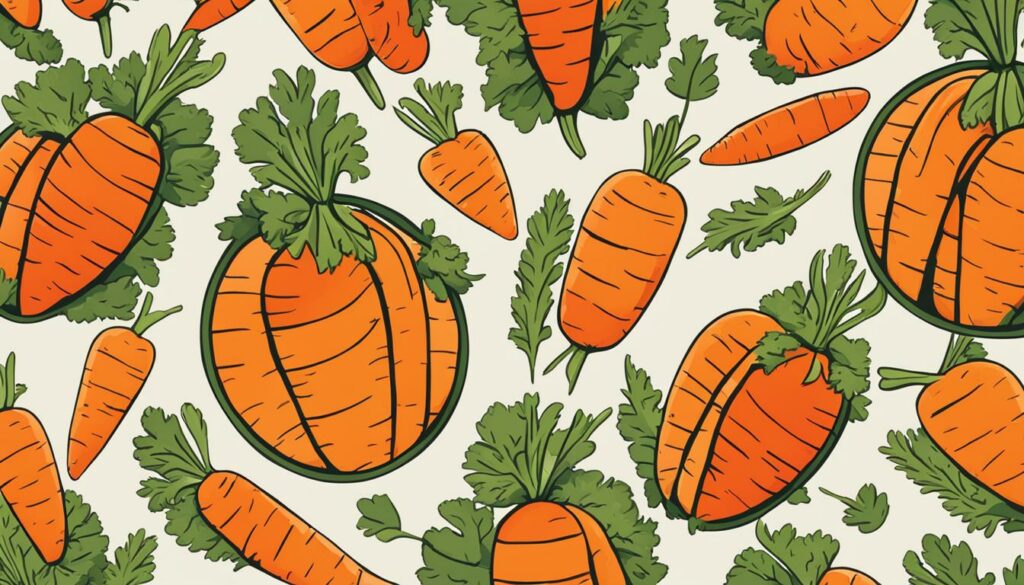
The Health Benefits of Carrots
Carrots offer numerous health benefits due to their rich nutritional content. Here are some of the key advantages of incorporating carrots into your diet:
- Promotes eye health: Carrots are rich in beta-carotene, which is converted to vitamin A in the body and supports healthy vision.
- Aids in weight management: Carrots are low in calories and high in fiber, making them a satisfying snack that can help with weight control.
- Boosts immunity: The antioxidants in carrots strengthen the immune system and protect against free radicals.
- Supports heart health: The potassium in carrots helps regulate blood pressure, reducing the risk of cardiovascular diseases.
- Reduces the risk of certain cancers: The antioxidants and dietary fiber in carrots have been associated with a lower risk of certain types of cancers, particularly lung and colorectal cancer.
With their nutritional value and associations with health and longevity, it’s no wonder that carrots have become a beloved vegetable worldwide. So, embrace the symbolism and enjoy the many benefits that carrots offer!
The Environmental Impact of Carrot Production
Carrot production, like any agricultural endeavor, has environmental implications. The cultivation of carrots involves various practices that can impact the environment if not managed sustainably. Here, I will discuss the environmental impact of carrot farming and the importance of sustainable carrot cultivation.
One of the key concerns in carrot production is the use of fertilizers and pesticides. While these inputs are necessary for crop growth and protection, improper usage can lead to water pollution and soil degradation. Excess fertilizers can leach into water bodies, causing nutrient imbalances and harmful algal blooms. Pesticides, if not applied judiciously, can harm beneficial insects and contaminate surrounding ecosystems.
Water resources also play a crucial role in carrot farming. Irrigation is essential for crop growth, but inefficient water usage can strain local water supplies. Over-irrigation can lead to waterlogging and water wastage, while under-irrigation can hinder crop development. Managing water resources efficiently, using techniques such as drip irrigation and monitoring soil moisture levels, can help minimize the environmental impact of carrot production.
| Environmental Impact | Sustainable Solution |
|---|---|
| Water pollution | Proper fertilizer and pesticide management |
| Soil degradation | Implementing soil conservation practices |
| Water usage | Efficient irrigation techniques |
To mitigate these environmental concerns, sustainable carrot cultivation practices are essential. Organic farming methods can reduce reliance on synthetic fertilizers and pesticides, promoting soil health and biodiversity. Crop rotation and cover cropping can help prevent soil erosion and nutrient depletion. Integrated pest management strategies can minimize the use of chemicals by employing natural predators and beneficial insects.
In conclusion, carrot production has an environmental impact that needs to be addressed through sustainable farming practices. By adopting methods that conserve water, minimize chemical usage, and protect soil health, we can ensure the long-term sustainability of carrot cultivation. It is crucial for the agricultural industry to prioritize environmental stewardship and work towards a more sustainable future.
Carrots in Popular Culture and Traditions
Carrots have made their way into popular culture through various references in literature, movies, and art. Their vibrant color, unique shape, and versatile nature have made them a symbol of health, vitality, and culinary delight. Carrots have become iconic in popular culture, representing both their nutritional value and aesthetic appeal.
In literature, carrots are often featured as a symbol of abundance and fertility. In the famous novel “Alice in Wonderland” by Lewis Carroll, the White Rabbit carries a pocket watch and is constantly in a hurry, leading Alice on a whimsical adventure. The White Rabbit’s obsession with time is paralleled with his fondness for carrots, which is an interesting nod to the vegetable’s association with growth and the passage of time.
In cinema, carrots have been immortalized in the iconic scene from the movie “A Christmas Story”, where the character Ralphie imagines himself as a sharpshooter saving his family from bandits. As he fights off imaginary foes, he skillfully attempts to extract a carrot from the dinner table using his BB gun. This memorable scene showcases the versatility of carrots as a prop, adding humor and a touch of whimsy to the film.
Carrot festivals are held in various parts of the world to celebrate this vibrant vegetable. These festivals not only showcase the cultural significance of carrots but also the creativity and culinary expertise of local communities. One such festival is the Holtville Carrot Festival in Holtville, California, which has been held annually since the early 1950s. The festival features a parade, carrot-themed competitions, and a variety of carrot-based dishes and delicacies. These festivals bring people together to appreciate the versatility and nutritional benefits of carrots while fostering a sense of community and cultural pride.
“Carrots are not just a healthy and nutritious vegetable, but also a symbol of vitality and cultural significance. Whether they are featured in literature, movies, or celebrated in festivals, carrots continue to captivate our minds and palates.”
Table: Carrot Festivals Around the World
| Festival | Location | Date |
|---|---|---|
| Holtville Carrot Festival | Holtville, California | February |
| Carrot Fest | Bradford, Ontario, Canada | August |
| Carrot Days | Oslo, Norway | August |
| Carrot Festival | Gimhae, South Korea | August |
| Carrot Carnival | Erewash, Derbyshire, UK | September |
Carrot festivals bring together people from different cultures and backgrounds to celebrate the humble carrot and its many virtues. From parades and competitions to culinary delights and cultural performances, these festivals embrace the rich symbolism and culinary versatility of carrots, making them an integral part of popular culture.
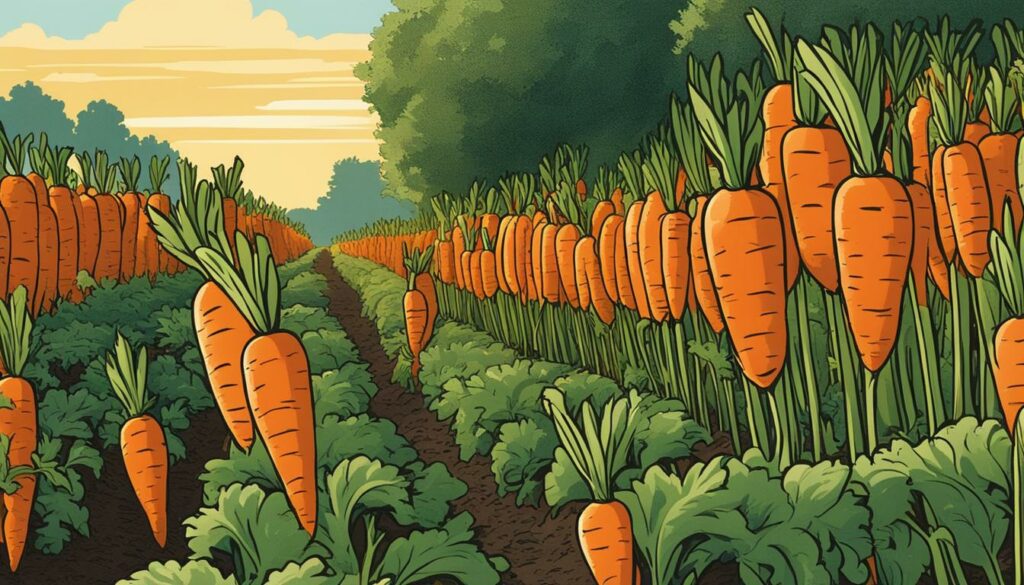
The Versatility of Carrots: From Cuisine to Beauty Products
Carrots are not only a staple in the culinary world but also have found alternative uses beyond the kitchen. Their rich antioxidant content and beneficial properties have made them a popular ingredient in beauty products and skincare routines. Carrots offer a range of benefits for the skin, making them a valuable addition to any skincare regimen.
Carrots are known for their high levels of beta-carotene, which is converted to vitamin A in the body. Vitamin A plays a crucial role in promoting healthy skin, as it helps to repair and regenerate skin cells. This makes carrots an excellent choice for skincare products, as they can help improve skin tone, reduce blemishes, and enhance overall skin health.
In addition to beta-carotene, carrots also contain other essential nutrients such as vitamins C and E, which are known for their antioxidant properties. These antioxidants help to fight against free radicals, protecting the skin from damage caused by environmental factors such as pollution and UV radiation. Carrots also provide hydration and moisturization to the skin, thanks to their high water content.
Carrot-based skincare products come in various forms, including masks, creams, and serums. These products are formulated to harness the benefits of carrots and deliver them directly to the skin. Whether you have dry skin, oily skin, or a combination of both, there is a carrot-based skincare product suitable for your needs.
So, if you’re looking to incorporate natural and nourishing ingredients into your skincare routine, consider the versatility of carrots. Explore the world of carrot-based skincare products and discover the benefits they can offer for your skin. From cuisine to beauty products, carrots truly stand out as a multi-purpose vegetable that promotes both health and beauty.
Conclusion
After delving into the world of carrots, it’s clear that this humble root vegetable is truly remarkable. From their various sizes, shapes, and colors to their versatility in the culinary world, carrots never fail to impress. They offer an array of health benefits, from promoting eye health to aiding digestion, boosting immunity, and even reducing the risk of certain cancers.
Whether you enjoy them raw or cooked, carrots add a delightful crunch and a slightly sweet and earthy flavor to your favorite dishes. And let’s not forget their cultural significance, from carrot festivals to their presence in popular culture and traditions around the world.
So, the next time you reach for a carrot, remember the incredible journey this vegetable has taken throughout history. Embrace its average size and explore the endless possibilities it offers in terms of flavor, nutrition, and visual appeal. Carrots truly are a wonderful addition to any meal, whether you savor them in a hearty stew or indulge in a decadent carrot dessert. So why not incorporate carrots into your diet and experience the many delights they have to offer?
FAQ
What is the average size of carrots?
Carrots come in various sizes, but the average size can vary. Some carrots measure under 15cm, while others can be 15-30cm or longer than 30cm.
How many calories are in carrots?
In 100g of carrots, there are approximately 41 calories.
What are the nutritional values of carrots?
Per 100g, carrots contain 88% water, 41 calories, 0.9g of protein, 9.6g of carbohydrates, and 0.2g of fat.
What are the different types of carrots?
Some popular types of carrots include Imperator carrots (long and pointed), Chantenay carrots (broad and stout), miniature carrots (tiny and ball-shaped), Nantes carrots (cylindrical and medium-sized), and Danvers carrots (easy to grow and thrive in most soil conditions).
How long does it take for carrots to be ready for harvesting?
Carrots are typically ready for harvesting within 90-100 days.
What are the health benefits of carrots?
Carrots promote eye health, help maintain a healthy body weight, reduce blood cholesterol levels, lower the risk of certain cancers, strengthen bones, aid digestion, and boost immunity due to their antioxidant properties.
How should carrots be stored?
Carrots can be stored properly in the refrigerator for several weeks or left in the ground over the winter for a sweeter and more flavorful vegetable.
Do carrots improve night vision?
While carrots are beneficial for overall eye health, the myth that they improve night vision is not supported by scientific evidence.
What is the environmental impact of carrot production?
Carrot production can have environmental implications, including water pollution and soil degradation. Sustainable farming practices can help minimize these impacts.
How are carrots used in popular culture?
Carrots are celebrated in carrot festivals and events worldwide, and they have become a symbol of health and vitality in the wellness industry.
Can carrots be used in skincare products?
Yes, carrots are used in beauty products and skincare routines due to their antioxidant content, which can promote healthy skin.
Source Links
- https://www.coolkidfacts.com/carrots-facts/
- https://www.foodrepublic.com/2014/11/24/10-things-you-didnt-know-about-carrots/
- https://facts.net/carrot-facts/

Hey lovely readers! My name is Chantal and I am obsessed with everything accessory and jewelry. My husband (and best friend) John and I, have been writing content for this blog for over 4 years now started the RTP store with over 4000 curated accessories and jewelry. We are traveling around the world to find the latest products, negotiate the best prices and find the best quality for our readers. We have managed to make our passion for feeling and looking good into our work. We are always open to new product suggestion, improvements or feedback. If you would like to chitchat with me, email me here!
